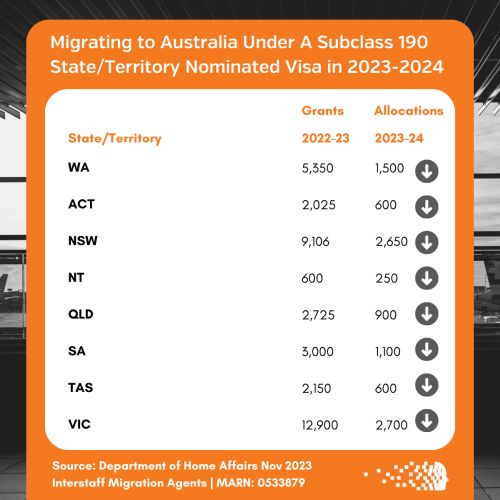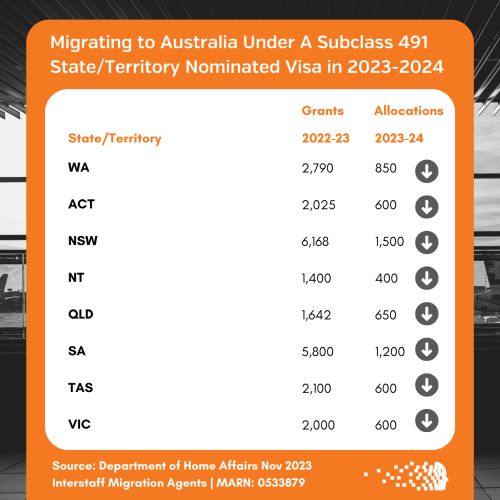State/Territory Visa Nominations | Interstaff Registered Migration Agents
Australia's state and territory nominated visa options to migrate without an employer sponsor have become more competitive due to the government significantly reducing its 2023-24 allocations for these visas.
Nomination allocations refer to the number of new primary applicants each state or territory can nominate in a program year. It is likely that the reduced availability of the state and territory nominated program may influence more intending migrants to consider pursuing employer-sponsored visa options.
Here's what you should know:
- How do you migrate to Australia without an employer sponsor? | State/Territory Nominated Visa options explainer
- How does a reduced state and territory nominated visa program impact skilled migrants?
- How do employer-sponsored pathways compare?
How Do You Migrate To Australia Without An Employer Sponsor? | State and Territory Nominated Visa Options
In Australia, permanent skilled migration places are divided between employer-sponsored visa options and the General Skilled Migration (GSM) program.
The GSM program is comprised of independent visas (such as the Subclass 189 Visa) and state and territory nominated visas (including the Subclass 190 State/Territory Nominated Visa and the Subclass 491 Skilled Work Regional (Provisional) State/Territory Nominated Visa).
Applying for a state or territory nominated visa involves four steps:
- Satisfying a points test, for which the applicant must obtain a positive Skills Assessment and Expression of Interest to migrate under an occupation in demand in the Australian economy. Points may be claimed in a range of categories, including age, English language ability, work experience in Australia and overseas, study in Australia, and other factors.
- A nomination by a State/Territory Government.
- An invitation from the Commonwealth Government.
- A visa application to the Department of Home Affairs for the relevant visa.
Applicants may be in Australia or overseas at the time they apply. The 190 Visa provides direct Permanent Residence (PR), whereas the 491 Regional Visa provides the option to apply for PR after 3 years of living and working in a regional area.
How the Reduction in State/Territory Nominations Impacts Skilled Visa Applicants
The below tables compare the 2022-2023 visa grants to the 2023-2024 state and territory nomination allocations for Subclass 190 and 491 Visas. As you can see, state and territory nomination allocations have been substantially reduced across Australia for both the 190 and 491 State/Territory Nominated Visas.
No state or territory allocations were issued for the 188 Business Innovation and Investment Visa in 2023-2024 as the Department of Home Affairs noted it had enough applications on hand from previous years to fulfill planning levels.


A reduction in state and territory nominations for 2023–2024 is likely to result in greater competition for nominations.
Applicants need to be aware that the points-based system requires a person to compete with other intending migrants who have submitted an Expression of Interest under the same occupation and state or territory.
Invitations are usually provided to applicants who score the highest for their occupation group, therefore in many cases, a person may need to score much higher than the pass mark.
It is still possible to migrate under a state or territory nominated visa, however you may wish to consult a Registered Migration Agent, such as Interstaff, who can provide professional advice based on your skills, qualifications and experience, and the states and territories that may require your skills.
How do Employer-sponsored Visas Compare?
Employer-sponsored visas are an alternative to GSM visas if your skills and experience are in demand in the Australian economy.
Depending on your eligibility, the Subclass 186 Direct Entry Stream Visa, or a temporary Subclass 482 TSS Visa or Subclass 494 Regional Visa may provide pathways to PR.
Interstaff's Visa Tool on Subclass 482 TSS Visas and Subclass 494 Visas may help to provide some initial information.
Government employment registers may be able to connect you to employers that may be interested in engaging skilled migrants; for example, the State Government of Western Australia's Skilled Migrant Employment Register helps skilled migrants connect with employers in the WA construction industry.
Why have State/Territory Nominations been reduced?
There may be a few reasons why state and territory visa nominations have decreased in 2023-2024, even though skills shortages are ongoing across Australia.
It is possible that the state and territory nominated program is being reduced while changes to its administration are being considered.
As part of its Migration Strategy Outline, the government identified a need to reform the points test to ensure it focuses on factors that maximise Australia's productivity and address ageing population challenges.
This could mean reshaping the points test to emphasise younger migrants with greater earnings potential, as well as reforming the Business Innovation and Investment programs.
Another reason could be the government's focus on returning to pre-pandemic levels of population growth.
Net Overseas Migration, which refers to the net gain or loss of population through international migration to and from Australia, has become a contentious topic in the media. This may have influenced the government to reduce the size of the state and territory nominated visa program in 2023-2024.
Source:
Interstaff's Registered Migration
Agents
Department of Home Affairs
The Migration
Institute of Australia
The content of this article is intended to provide a general guide to the subject matter. Specialist advice should be sought about your specific circumstances.
